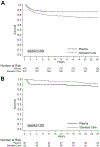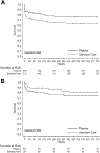Prehospital plasma is associated with survival principally in patients transferred from the scene of injury: A secondary analysis of the PAMPer trial
- PMID: 35864051
- PMCID: PMC9999176
- DOI: 10.1016/j.surg.2022.04.039
Prehospital plasma is associated with survival principally in patients transferred from the scene of injury: A secondary analysis of the PAMPer trial
Abstract
Background: We sought to characterize if prehospital transfer origin from the scene of injury (SCENE) or from a referral emergency department (REF) alters the survival benefit attributable to prehospital plasma resuscitation in patients at risk of hemorrhagic shock.
Methods: We performed a secondary analysis of data from a recently completed prehospital plasma clinical trial. All of the enrolled patients from either the SCENE or REF groups were included. The demographics, injury characteristics, shock severity and resuscitation needs were compared. The primary outcome was a 30-day mortality. Kaplan-Meier analysis and Cox-hazard regression were used to characterize the independent survival benefits of prehospital plasma for transport origin groups.
Results: Of the 501 enrolled patients, the REF group patients (n = 111) accounted for 22% with the remaining (n = 390) originating from the scene. The SCENE group patients had higher injury severity and were more likely intubated prehospital. The REF group patients had longer prehospital times and received greater prehospital crystalloid and blood products. Kaplan-Meier analysis revealed a significant 30-day survival benefit associated with prehospital plasma in the SCENE group (P < .01) with no difference found in the REF group patients (P = .36). The Cox-regression verified after controlling for relevant confounders that prehospital plasma was independently associated with a 30-day survival in the SCENE group patients (hazard ratio 0.59; 95% confidence interval 0.39-0.89; P = .01) with no significant relationship found in the REF group patients (hazard ratio 1.03, 95% confidence interval 0.4-3.0).
Conclusion: Important differences across the SCENE and REF cohorts exist that are essential to understand when planning prehospital studies. Prehospital plasma is associated with a survival benefit primarily in SCENE group patients. The results are exploratory but suggest transfer origin may be an important determinant of prehospital plasma benefit.
Copyright © 2022 Elsevier Inc. All rights reserved.
Conflict of interest statement
Conflicts of interest/Disclosure
The authors have no conflicts of interests or disclosures to report.
Figures



References
Publication types
MeSH terms
Substances
Grants and funding
LinkOut - more resources
Full Text Sources
Medical

